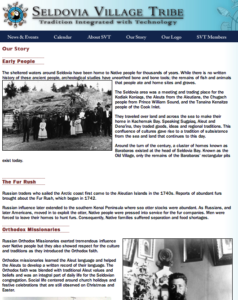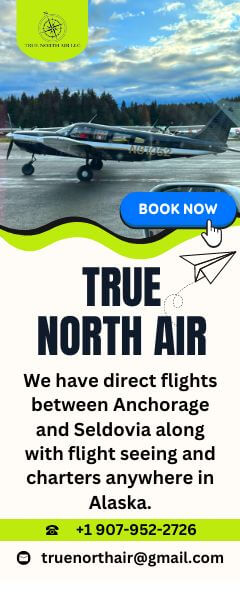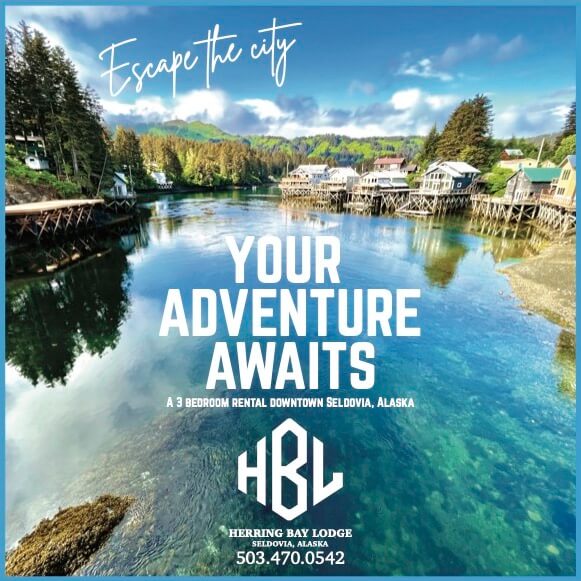History of Seldovia
 Seldovia has a rich history, please take a moment to click on this image to the left to view a historical account of Seldovia and her people. The Seldovia Village Tribe has a wealth of information about the history of our community and we are appreciative to have this information available to us!
Seldovia has a rich history, please take a moment to click on this image to the left to view a historical account of Seldovia and her people. The Seldovia Village Tribe has a wealth of information about the history of our community and we are appreciative to have this information available to us!
Please note that clicking on the image will take you off Seldovia.com and onto the SVT website.
For more interesting historical and anthropological information about Seldovia and her people, please visit the Seldovia Visitor’s Museum, located right off the small boat ramp on the corner of Main Street. There are many photos, artifacts and information about our community for you to explore.
Admission is complimentary.
Enjoy this timeline – showing the major events in Seldovia’s history.
|
to late
1800’s |
The History of Seldovia Athabascan Indians, Aleuts and Eskimos have camped at Seldovia for hundreds of years, but its modern history began in the late 1800’s. It is possible that prehistoric evidence of a village site may lie beneath the Russian Orthodox Church or other homes in the Seldovia city. Other excavations of ancient skeletal remains have turned up around the MacDonald Spit. |
|
1840
|
Chief manager of the Russian Colonies in North America, Mikhail Dmitrievich Teben’kov, sent Captain to explore Cook’s Inlet, including Seldovia. |
|
1852
|
Captain Archimandritov named the bay “Zaliv Seldevoy” or translated, “Herring Bay.” The Kenaitze Indian name for the Bay was Chesloknu. |
|
1867
|
Alaska purchased from Russia. Many Russians departed for their mother country; however heritage of the Russian culture still remain in Seldovia. |
|
1870
|
Russians and Natives who were engaged in fur hunting and trading settled here by the 1870’s. This makes it one of the oldest settlements in the Cook Inlet area. Over the years the processing of herring, crab and salmon have been important. An Indian village once flourished at the mouth of the Seldovia River. Also Captain Nathaniel Portlock discovered what may be the first coal mine in Alaska — 8 miles south of Seldovia. It was mined by the Russians for their settlements and the Russian fleet. |
|
1884
|
10th U.S. Census Population of Seldovia: 74 (including “island” which may have been the Yukon Island) |
|
1898
|
The Post Office in Seldovia was established. |
|
1900’s
|
At the turn of the century, Seldovia was a stop for prospectors enroute to the gold fields in the Interior. |
|
1908
|
First Public School in Seldovia was established. |
|
1910
|
The first salmon cannery was built around 1910. |
|
1910
|
Juneau became the capital city of Alaska. |
|
1920
|
A herring boom in the 1920’s brought Scandinavians to town and they stayed on to fish salmon, halibut, crab. First record of a 4th of July Celebration in Seldovia. |
|
1925
|
More than fifty fox farms were established in the bays and coves of the peninsula, many of them using Seldovia as the point of supply. During these years, Seldovia was the commerce center for all of Western Alaska. Powder Island also had a sawmill, which caught fire and burned down. |
|
1927
|
Seldovia’s canneries were thriving businesses. |
|
1931
|
In 1931 a wooden boardwalk was built along the waterfront to facilitate travel through town. Businesses in buildings set on pilings flourished along the intimate wooden walkway, and Seldovia became known throughout Southcentral Alaska as “the boardwalk town.” The boardwalk was also social gathering place. Even today, the charm of old Seldovia is retained in an original section of the old boardwalk which remains along the Seldovia Slough. |
|
1945
|
Seldovia’s first airplane service: Miller’s Seldovia Air Service – 6 passenger double wing Waco float plane, pilot was Dick Miller. The plane was tethered to the Seldovia dock. This was also the year that Seldovia was incorporated as a “Second Class City,” with 285 residents. Seldovia’s canneries were no longer a thriving business. |
|
1946
|
Seldovia’s current air strip was built. |
|
1947
|
Children’s ski tow built on the Frank Raby Hill (behind the old Beachcomber Hotel) by Dr. Melvin Belz and Everd Jones. The first radio telephone transmitter was installed in June, enabling communication between Seldovia and Anchorage. |
|
1962
|
Seldovia was reclassified as a “First Class City.” |
|
1964
|
The 1964 earthquake changed Seldovia forever. The land mass subsided four feet, allowing high tides to wash over the boardwalk and into its buildings- houses and stores. The waterfront boardwalk was replaced and renewed with fill from surrounding hills so the the town could be rebuilt on higher ground, above high tides. |
|
1971
|
Construction began on the Susan B. English School. First classes held on August 30, 1972. Dedication Ceremony on September 30, 1972. |
|
1975
|
Seldovia Native Association sold some of its logging rights to Robertson & Sons who milled about 5 million feet of Sitka spruce. In later years more logging was done. |
|
Today
|
Seldovia is an active and fun community, has a wonderful school (grades 1-12), invites tourism, is an attractive retirement place, and supports the sport fishing industry. |








